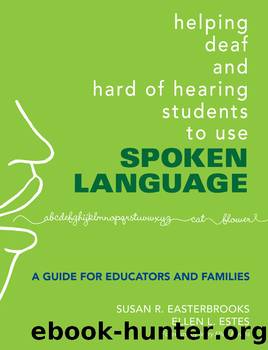Helping Deaf and Hard of Hearing Students to Use Spoken Language by Susan R. Easterbrooks

Author:Susan R. Easterbrooks [Easterbrooks, Susan R.]
Language: eng
Format: epub
ISBN: 978-1-4522-9338-7
Publisher: SAGE Publications
Published: 2007-05-24T00:00:00+00:00
Mr. Jensenâs first-grade class is working on a unit on plants, in particular, the concept that plants need water, sunlight, warmth, and soil. The language goals on Freddaâs IEP include the infinitive (uninflected verb form: to _____; for example, to eat), pronouns we and they, and the conjunctions before and after. Her speech goals include the production of the /s/ sound in the final position in words and the -ee-. Freddaâs auditory goal is that she will demonstrate identification and comprehension (brain tasks) of -ee- versus -o- (listening and speaking skill) given words and in phrases of four words in length (linguistic complexityâexternal factor) by repeating the phrases correctly (child action). Mr. Jenson collaborates with Mrs. Troutman, the teacher of the deaf, and Ms.Gilbert, the speech-language pathologist. The collaborative notes from the team meeting indicate the following:
Concept: Plants need water, sunlight, warmth, and soil.
Language: Infinitive: Plants need to have water. We have to put plants in the sun.
Plants need warmth to grow.
Pronoun: Plants are living things. They need water to live.
Conjunction: You need to water your plants after you put them in the soil.
Speech: /s/: plants, pots; -ee-: need, seed, we
Auditory: -ee- versus -o-: seed, need, we versus pot, hot, lot (e.g., a lot of water!)
They also determine who is responsible for each aspect of the unit and how tasks will be accomplished. For example, Mrs. Troutman, the teacher of the deaf, might work on teaching about infinitives and their uses. She might also work on listening activities by comparing the sounds identified. Ms. Gilbert, the SLP, might work on teaching the child to say the correct sounds. Mr. Jensen would focus on incorporating language, speech, and auditory goals into the lesson to reinforce what the others have worked on. For example, when the child mispronounces the word âseed,â he could ask her to repeat the word âthe way you do for Ms. Gilbert.â He might also provide Fredda with auditory experiences including asking her to âplant the seedâ or âpull the weed.â Later he will engage Fredda in a conversation about the garden he is planting to help her extend her ability to listen to and use the words and language structures she is practicing.
Download
This site does not store any files on its server. We only index and link to content provided by other sites. Please contact the content providers to delete copyright contents if any and email us, we'll remove relevant links or contents immediately.
| Behavioral Disorders | Communicative Disorders |
| Gifted Students | Inclusive Education |
| Learning Disabled | Mentally Disabled |
| Physically Disabled |
The Art of Coaching Workbook by Elena Aguilar(48552)
Trainspotting by Irvine Welsh(20130)
Twilight of the Idols With the Antichrist and Ecce Homo by Friedrich Nietzsche(17744)
Fangirl by Rainbow Rowell(7880)
Periodization Training for Sports by Tudor Bompa(7366)
Change Your Questions, Change Your Life by Marilee Adams(6693)
This Is How You Lose Her by Junot Diaz(5835)
Grit by Angela Duckworth(4767)
Red Sparrow by Jason Matthews(4726)
Asking the Right Questions: A Guide to Critical Thinking by M. Neil Browne & Stuart M. Keeley(4633)
Paper Towns by Green John(4199)
Room 212 by Kate Stewart(4143)
Ken Follett - World without end by Ken Follett(3998)
The Sports Rules Book by Human Kinetics(3622)
Housekeeping by Marilynne Robinson(3449)
The Motorcycle Diaries by Ernesto Che Guevara(3369)
Exercise Technique Manual for Resistance Training by National Strength & Conditioning Association(3324)
Introduction to Kinesiology by Shirl J. Hoffman(3323)
Double Down (Diary of a Wimpy Kid Book 11) by Jeff Kinney(3310)
